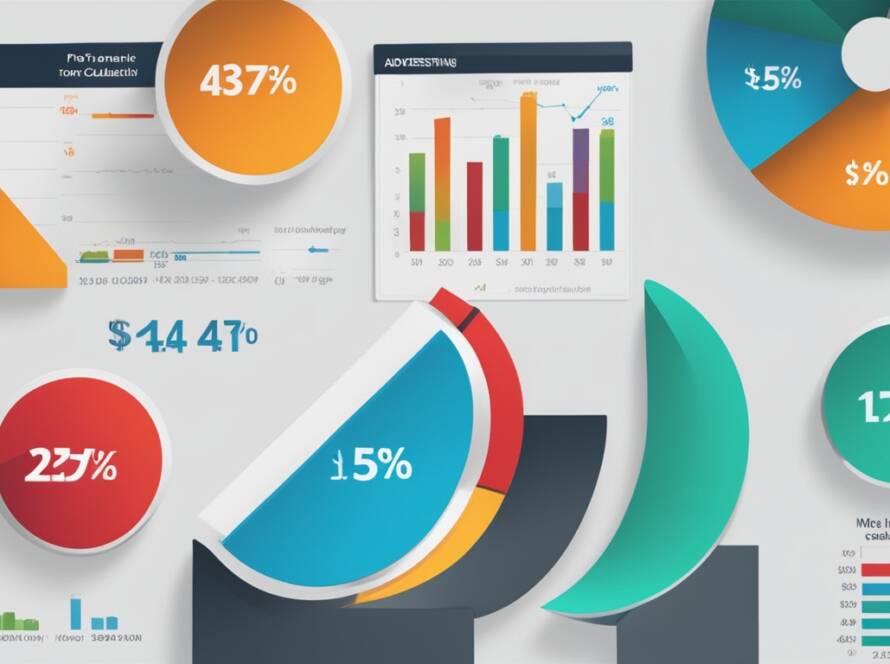Knowing how well your marketing campaigns perform is key to their success and future planning. When it comes to Calculating ROI in Digital Marketing, use the formula (net profit/total digital marketing costs) x 100. This calculation reveals the profit you gain from your marketing efforts compared to what it costs, providing a clear measure of your campaign’s effectiveness.
Looking at ROI helps businesses make better decisions and possibly earn more. A good ROI is about 5:1, meaning your campaign makes five times what it costs. An amazing ROI is closer to 10:11. These numbers show why it’s vital to deeply understand ROI.
Tools like the Web AI Engine give businesses deep insights. They help improve strategies and get big returns. Using these tools changes how you track and boost your digital marketing for better ROI and smarter budget use.

Key Takeaways
- ROI in digital marketing helps measure campaign success by comparing net profit to marketing costs.
- A good ROI benchmark is 5:1, while an exceptional ROI is around 10:11.
- Understanding and calculating ROI is essential for refining digital marketing strategies.
- Utilising tools like the Web AI Engine can enhance efforts and optimise ROI.
- Accurate ROI analysis aids in effective budget allocation and future strategy adjustments.
Understanding ROI in Digital Marketing
In today’s world, knowing how to measure ROI in digital marketing is key. ROI, or Return on Investment, shows us how well our online marketing works. It helps us see which strategies make money and which ones don’t. Digital marketing tools like search engines, company websites, and social media are crucial for this2.
What is ROI in Digital Marketing?
ROI in digital marketing is about checking how much money our campaigns make. We find ROI by taking the revenue from our marketing and subtracting the costs. Then, we divide that number by the total costs. For instance, if our campaign costs £5000 and makes £30,000, the ROI is 500%3.
Another way to look at ROI is as a ratio, like 5:1. This means for every £1 we spend, we make £5 in profit3.
Deeper analysis can show us more about our marketing, like how much each click costs and how campaigns affect sales. These details help us make our marketing better and more profitable. Sometimes, we need to use special methods to measure ROI, depending on our marketing channels and goals3.
To track our marketing well, we use tools like Google Analytics. It helps us see things like where our traffic comes from and how many people are converting. Google Data Studio is also great for showing us how our marketing is doing with charts and reports3. We can set up custom goals in Google Analytics to track things like sales or form submissions, giving us a clear view of ROI3.
Tracking pixels help us see where our traffic comes from and improve our ads. CRM tools are good for following leads from the start to the sale2. A good ROI ratio is usually 5:1, but it depends on costs and goals2. ROI is also about long-term goals, like building leads that might not pay off right away but bring in money later2.
Calculating ROI
Understanding the return on investment (ROI) in digital marketing is key to knowing if your efforts are profitable. An effective ROI analysis helps businesses make the most of their digital marketing strategies. Using an investment return calculator can make these evaluations easier.
Basic ROI Formula
The basic formula for ROI is simple: ROI = (Gain from Investment – Cost of Investment) / Cost of Investment4. For example, if Bob’s sheep farming started with a $50,000 investment and made $70,000, his ROI was 40%4. This gives a quick look but doesn’t consider sales that would have happened anyway.
Advanced ROI Calculations
Advanced calculations go deeper than the basic formula. They subtract organic growth to see the real effect of marketing. Annualised ROI gives a clearer picture by looking at the investment’s length5. With different definitions of ‘cost’ and ‘gain’, especially in digital marketing, deeper analysis is needed. For example, energy and utilities have different ROI goals than tech companies, which often beat the S&P 500’s 10% annual return6.
Common Challenges in ROI Calculation
Calculating marketing ROI has its hurdles. It’s hard to see long-term effects, separate sales growth from other goals, and figure out conversion value. ROI in digital marketing includes various costs like ad spend and agency fees5. To overcome these issues, you need detailed tools and analytics. Tools like the Web AI Engine offer deep insights, helping marketers improve their strategies and campaign results4.
Tools and Metrics for Measuring Digital Marketing ROI
Using the right ROI tools is key for marketers to see how well their campaigns do and to boost their results. Important metrics like conversion rate, customer acquisition cost (CAC), and customer lifetime value (CLV) help show how effective digital marketing is. By using tools like Google Analytics, businesses can make sure their marketing matches their ROI goals.
Google Analytics
Google Analytics is vital for deep analysis and improvement. It has features like goal tracking, e-commerce tracking, and custom reporting to track digital marketing well7. Using UTM parameters lets businesses keep an eye on each campaign by adding special tags to URLs7. Pixels or tags help track conversions to see how each marketing channel works7.
Other Helpful Tools
Marketers can also use tools like Adobe Analytics, Kissmetrics, and Mixpanel7. These tools give detailed analytics for different needs, helping to analyse marketing across various channels. Tools like Cyfe and SEMrush track marketing efforts in areas like content marketing and SEO. These tools help marketers decide where to spend resources and how to improve campaigns.
Important Metrics to Track
It’s important to track key metrics to measure digital marketing ROI. These include:
- Conversion Rate: Conversions divided by the number of clicks8
- Customer Acquisition Cost (CAC): Marketing costs divided by the number of sales earned8
- Customer Lifetime Value (CLV): (Average annual revenue per customer x average number of years as a customer) – customer acquisition cost8
- Return on Advertising Spend (ROAS): Revenue from ads divided by ad spend7
Comparing ROI with industry averages and competitors shows how well marketing is doing7. By always improving and learning from successful examples, businesses can get better at digital marketing ROI.
| Metric | Description |
|---|---|
| Conversion Rate | Conversions divided by the number of clicks8 |
| Customer Acquisition Cost (CAC) | Marketing costs divided by the number of sales earned8 |
| Customer Lifetime Value (CLV) | (Average annual revenue per customer x average number of years as a customer) – customer acquisition cost8 |
| Return on Advertising Spend (ROAS) | Revenue from ads divided by ad spend7 |
Conclusion
Calculating ROI is key to knowing how much profit comes from an investment. It’s vital in digital marketing to see how well campaigns work and where to invest next. Knowing the difference between expected and actual ROI is important. A positive ROI means you made a profit, while a negative one means you lost money.
For instance, buying chocolates for $2 each, selling them for $3, and spending $100 on transport can give a 42.9% ROI9. This shows how well our digital marketing is doing.
Choosing the right tools and methods is crucial for improving ROI. Tools like Google Analytics give us a detailed look at our ROI and help us spend our marketing budgets wisely10. It’s key to remember that ROI shows profit as a percentage but doesn’t account for the time value of money or when the ROI is seen. This is important for planning for the long term and measuring marketing success.
Understanding and calculating ROI helps businesses make better decisions in digital marketing. This leads to better decision-making and growth. Using advanced tools like Web AI Engine can improve our insights. It lets us not just measure but also improve every part of our digital marketing for better ROI and marketing success11.
Source Links
- https://www.investopedia.com/articles/personal-finance/053015/how-calculate-roi-marketing-campaign.asp
- https://www.business.com/articles/how-to-measure-digital-marketing-roi/
- https://www.webfx.com/digital-marketing/learn/how-to-measure-digital-roi/
- https://www.calculator.net/roi-calculator.html
- https://www.investopedia.com/articles/basics/10/guide-to-calculating-roi.asp
- https://www.investopedia.com/terms/r/returnoninvestment.asp
- https://www.linkedin.com/pulse/measuring-digital-marketing-roi-quick-guide-richard-garuba-1nqrf
- https://www.webfx.com/blog/marketing/digital-marketing-roi-metrics/
- https://online.hbs.edu/blog/post/how-to-calculate-roi-for-a-project
- https://www.carboncollective.co/sustainable-investing/return-on-investment
- https://corporatefinanceinstitute.com/resources/accounting/return-on-investment-roi-formula/


